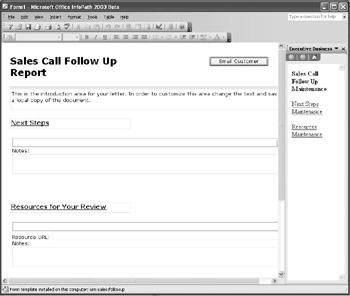Sales Call Report Example
CD-ROM Two of the most common problems in any sales- related organization are performing follow-ups and providing information back to both customers and even managers. Typically, sales call follow-ups may include a variety of different process types and even workflow agents . The reality is that often even the most advanced Customer Relationship Manager (CRM) applications don t provide an easy-to-use tool for providing simple repetitive information. (The Sales Call Report example is found on the companion CD-ROM in \Code\Chapter 6\Sales Follow Up\ebr.xsn.)
The form shown in Figure 6.20 is designed to solve this type of process and allow an easy-to-use ad hoc-based workflow that reduces the overall time it takes for a person to respond back to a customer. It provides a generic template that can be used by salespeople as a way of responding back to a customer. This solution also provides an offline component that can be used to easily capture existing knowledge and allow its reuse. One of the most important features of this type of application is the use of a custom task pane to help control, collect, and reuse the information entered by the user .

Figure 6.20: Displaying the Sales Call form.
Task Panes
Task panes allow you to define a process or amplify information within an InfoPath form. They often provide either a collection point or allow you to access external information within the form. They are simply HTML files that are made part of the solution and contained with the solution file. Task panes enable you to store and maintain a variety of information.
The task pane object model is maintained as part of the InfoPath object model and allows you to share the objects and script components that are maintained within the project. For example, within task panes, you can access both global variables and business-based functions using the window object of the task pane, as shown here:
\accessing global variable window.external.Window.XDocument.Extension.MyVariable \accessing function defined within the business logic window.external.Window.XDocument.Extension.MyFunction()
| Note | InfoPath allows you to script external objects. Using the wscript object model, you can load the network name of the person that is filling out the form into a text box using this syntax: var objNetwork = new ActiveXObject("WScript.network"); objMail.BCC = objNetwork.UserName; |
This will, by default, generate a security error unless the form is fully trusted. This will be discussed further in Chapter 9.
Within the Sales Call example, the task pane is used to collect and store information that the user enters and then can be used to refresh the drop- downs with this information using the DataObjects function here:
function refreshDrops() { XDocument.DataObjects("Next Steps").Query(); XDocument.DataObjects("Resources To Review").Query(); XDocument.View.ForceUpdate(); } This function is then callable from the task pane and refreshes the current data sources, as shown here:
window.external.Window.XDocument.Extension.refreshDrops()
EAN: 2147483647
Pages: 111